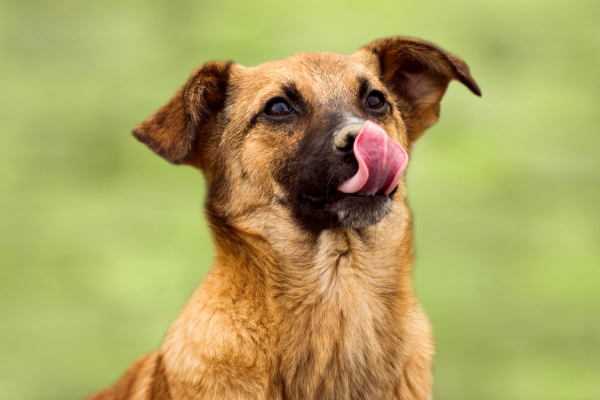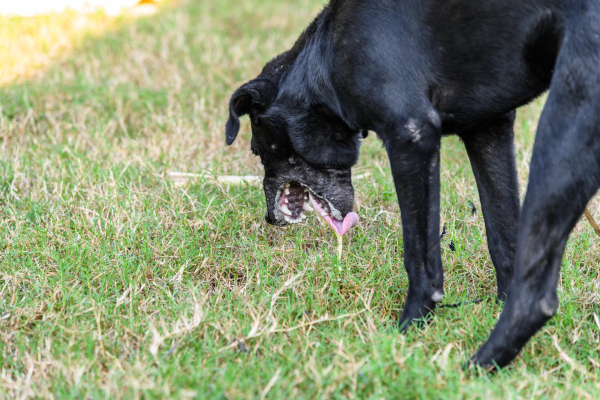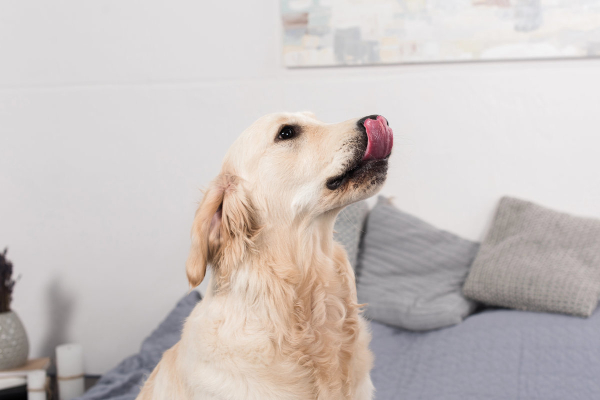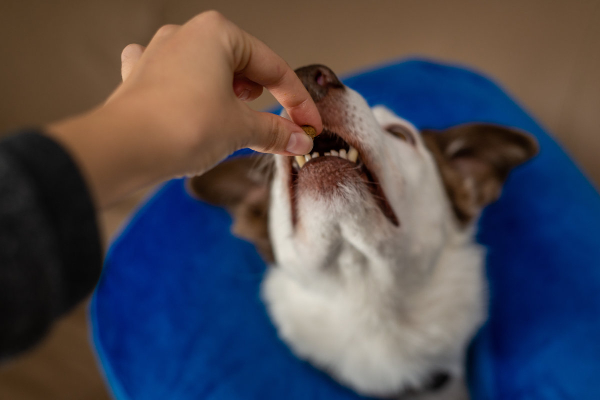Esophagitis in dogs (i.e. inflammation of the esophagus) is a condition that likely remains undetected far too often. To help you recognize potential signs of esophagitis so your dog can get the help he or she needs, integrative veterinarian Dr. Julie Buzby explains the symptoms, causes, diagnosis, treatment, and prognosis for esophagitis in dogs.

Esophagitis, or inflammation of the esophagus, affects dogs of all breeds and ages. Yet its symptoms can be subtle, are easily mistaken for other common GI issues, or can be simply overlooked.
Educating yourself about esophagitis can empower you to recognize potential symptoms in your beloved pup. That way you can seek veterinary attention promptly. This proactive approach can lead to earlier diagnosis and better outcomes for affected dogs, which is a winning combination for everyone involved.
What is esophagitis in dogs?
Esophagitis in dogs is inflammation and irritation of the esophagus which may occur for a variety of reasons. To understand esophagitis, you first need to know a bit more about the esophagus.
The esophagus is a flexible muscular tube that connects the mouth to the stomach. When your furry friend swallows, muscles in the esophagus contract, pushing the food or water down toward the stomach.
Now here’s where it gets interesting. The esophagus is so important to digestion that the body has developed a defense system to keep it in working order. A mucous membrane layer lines the esophagus to help protect it from scratches and irritation caused by food, or more importantly, by non-food items that your dog may gulp down in a moment of weakness.
But sometimes things don’t go as smoothly as planned. And even the best defense mechanisms aren’t foolproof. If your dog swallows something sharp, caustic, or that is too big to pass into the stomach, or if your pup has a medical condition like acid reflux, it can irritate the lining of the esophagus. The end result is esophageal inflammation—which is also known as esophagitis.
What are the symptoms of esophagitis in dogs?
As mentioned earlier, esophagitis is likely underdiagnosed. This is because the signs associated with it can be subtle or even absent, especially if it is mild. It is also challenging to diagnose esophagitis without more advanced procedures, which we will delve into more later. Plus, the symptoms of esophagitis can mimic the signs of many other gastrointestinal diseases.
All these things taken together mean that many more pups probably suffer from esophagitis at some point in their lives than we are even aware of.
Just like with many other disease processes, the signs of esophagitis vary significantly depending on the severity of the esophageal inflammation. And you can see most of these signs with other conditions aside from esophagitis.
So what are some of the signs of esophagitis in dogs that you might want to watch out for?
Regurgitation
The inflammation associated with esophagitis wreaks havoc on the normal muscular function of the esophagus. So instead of the esophagus helping food travel down into the stomach, food just sits in the esophagus. The food might stay there for minutes, or even many hours. But eventually if the food can’t get to the stomach, it will make its way up and out of the mouth again instead. This is regurgitation.
Regurgitation can be tricky to differentiate from vomiting, but the distinction is important. Unlike vomiting, which is active and the material originates in the stomach, regurgitation involves the effortless expulsion of undigested food or liquid from the esophagus.
Vomiting comes with abdominal contractions, while regurgitation is often sudden and silent. And with vomiting, many dogs show signs of nausea first, such as drooling, pacing, or a dog who keeps licking his or her lips. But dogs with regurgitation generally don’t have any of these signs prior to regurgitating.

Difficulty swallowing
Also known as dysphagia, difficulty swallowing means your dog is struggling when swallowing food or water. He or she may make repeated attempts to swallow or exhibit signs of discomfort while eating. The swallowing may also appear exaggerated, with more noticeable head movement or the neck extended.
Gagging or coughing
Irritation of the esophagus can trigger a dog to cough and gag. These signs might be especially prevalent soon after eating or drinking.
Excessive salivation or drooling
Drooling is also called ptyalism. And is related to saliva that builds up in the mouth when swallowing becomes painful or difficult.
Decreased or absent appetite
Esophagitis can lead to a decreased interest in food due to pain or discomfort associated with swallowing.
Unusually bad breath
This is a less common sign. But esophagitis can sometimes cause bad breath in dogs due to regurgitated food lingering in the esophagus or from the esophageal inflammation itself.
Lip smacking, teeth grinding, or air licking
Due to discomfort from esophagitis, the dog may smack his or her lips or grind his or her teeth. Or you may notice your dog keeps licking the air.
If you are worried that your beloved canine companion might be suffering from esophagitis, the first step is to consult your veterinarian. He or she can help advise you on how best to proceed. Often, this will be an office visit for a thorough history, physical exam, and diagnostics.

What causes esophagitis in dogs?
During the appointment, your veterinarian will ask you questions about your dog’s history. This is a good way for him or her to start creating a list of potential culprits. When it comes to esophagitis, anything that injures or significantly irritates the esophagus could be the inciting factor.
Some of the most common causes of esophagitis in dogs include:
Ingestion of a foreign object
If a dog ingests an object that becomes lodged in the esophagus, he or she may develop esophagitis. The esophagus is flexible, but its stretchiness has a limit. Foreign bodies that stretch the esophagus but can’t pass through can be especially damaging.
This is the case because esophageal foreign bodies can cause pressure necrosis (i.e. tissue death due to pressure). The longer the foreign object is pressed up against the esophageal wall, the more substantial the damage is likely to be.
Some common culprits include rawhides, bones, bully sticks, and corn cobs. But dogs are curious creatures and their penchant for mischief knows no limits. So the list of foreign objects that could cause esophagitis is virtually infinite.
Gastroesophageal reflux disease (GERD)
Similar to humans, dogs can experience reflux of stomach acid (i.e. gastric acid) and digestive enzymes into the esophagus. This is called gastroesophageal reflux disease or GERD. The stomach has protective mechanisms against the gastric acidity levels. But the lining of the esophagus is not meant to be bathed in acid. So the refluxed fluid leads to irritation and inflammation.
There is an unfortunate chicken-and-the-egg type phenomena related to acid reflux in dogs and esophagitis. Esophagitis can contribute to worsening reflux, and worsening reflux can lead to esophagitis, and on and on unless the cycle can be broken with treatment.
Anesthesia
One of the more common causes of esophagitis is a recent anesthetic event. Anesthesia weakens the tone of the lower esophageal sphincter, the structure that usually prevents stomach acid from flowing back into the esophagus.
If the anesthetic procedure also requires the dog to lay on his or her back, this can increase the risk that stomach fluid might reflux out of the stomach and pool in the esophagus, causing esophagitis.
Vomiting
Frequent or severe vomiting from any cause can expose the esophagus to harsh stomach acid and lead to esophagitis.
Medications
Certain medications, especially oral antibiotics like doxycycline, clindamycin, and ciprofloxacin, may irritate the esophagus. To decrease the esophagitis risk, administer the medication. And then immediately feed your dog a small meal or make sure he or she drinks some water. Both of these tricks help ensure that the pill goes down into the stomach and doesn’t sit in the esophagus where it might damage the esophageal lining.
Ingesting caustic substances
Ingestion of caustic chemicals or toxic substances can damage the lining of the esophagus, leading to inflammation and esophagitis. Cleaning products are one of the most common culprits. Dogs can get them on their feet or fur and then lick them off.
Infections
Spirocerca lupi is a relatively uncommon parasitic worm that can cause esophagitis in dogs. It has a complex lifecycle that involves multiple hosts.
The adult worms live in the esophagus of infected animals where they can cause nodules. The worms lay eggs that are passed in the feces. Intermediate hosts, such as dung beetles or cockroaches, ingest the eggs, which then develop into infective larvae. When a dog ingests an infected dung beetle or cockroach, the larvae migrate to the walls of the esophagus, where they mature into adult worms, completing the lifecycle.
This is all very gross, and luckily quite uncommon. But it still remains an important differential for dogs with esophageal disorders.
Hiatal hernias
Hiatal hernias occur when a portion of the stomach protrudes through the esophageal hiatus and into the chest cavity. The esophageal hiatus is the normal opening in the diaphragm through which the esophagus passes before connecting to the stomach. But in cases of hiatal hernias, this opening becomes enlarged or weakened, allowing a portion of the stomach to slide or bulge upward into the chest cavity.
Hiatal hernias in dogs can be congenital (i.e. present at birth) or acquired later in life. Shar-Peis and brachycephalic dog breeds like Bulldogs, Boston Terriers, and Pugs are all predisposed to developing hiatal hernias.
Breed predisposition
On top of being more prone to developing hiatal hernias, brachycephalic dogs seem to have an increased incidence of gastroesophageal reflux and esophagitis. It is theorized this is the case because their airway conformation puts extra pressure on their abdominal cavity since they have to work harder to breathe.

Eating very hot food
I personally know of at least one case of a dog stealing a sausage straight off a grill and ending up with severe esophagitis and an esophageal stricture due to the scalding hot food burning the esophagus on the way down.
While there are many potential causes of esophagitis, your veterinarian will use his or her unique knowledge of your pup’s signs and symptoms to try to determine the underlying cause of the esophagitis. This will allow your vet to select the appropriate treatment and try to prevent recurrence, which increases the odds of a good outcome for your furry family member.
How will your veterinarian diagnose esophagitis?
As with most ailments, after gathering a thorough history, the vet will start by performing a clinical exam. Since the signs of esophagitis can mimic the signs of many other illnesses, the vet might also recommend running some basic blood tests for dogs like a blood chemistry and complete blood count (CBC). This lab work can help rule out other conditions. But there are no specific lab work abnormalities that point directly to a diagnosis of esophagitis.
Esophagoscopy
In fact, the main diagnostic tool for officially diagnosing esophagitis is esophagoscopy. For this procedure, the vet passes a flexible tool with a camera attached (an endoscope) into the esophagus. Understandably, general anesthesia is required during esophagoscopy, making it a more involved test to perform.
The benefit is that the esophagoscopy allows the vet to visualize the esophagus and assess it for redness, irritation, or even bleeding, all of which can be seen with esophagitis. Esophagoscopy also lets the veterinarian look for any other esophageal abnormalities such as foreign bodies, esophageal strictures, or masses.
Esophagoscopy does require specialized equipment, so it cannot be performed at every veterinary clinic. This, and the fact that the procedure is more involved and therefore also more costly, means that many dogs with suspected esophagitis don’t receive an official diagnosis. Instead the vet treats them for presumed esophagitis based on their signs and symptoms.
Chest x-rays
Chest X-rays are a good idea to perform prior to esophagoscopy, not because they can help diagnose esophagitis, but because they can assess the dog for some of the other complications of esophagitis. For example, esophagitis can lead to aspiration pneumonia or megaesophagus, which might make general anesthesia for esophagoscopy a bit risker.
What is the treatment for esophagitis in dogs?
The treatment of esophagitis in dogs typically involves a combination of medical management and general supportive care. Plus, it is important to address any identified underlying causes.
Medications
Medical management of esophagitis may involve the following medications:

- Acid-reducing medications—Proton pump inhibitors (like omeprazole for dogs) or H2 receptor antagonists (like famotidine) help to reduce stomach acid production and minimize acid reflux. Proton pump inhibitors tend to be more effective, so they are the treatment of choice.
- Medication to protect the esophagus—Sucralfate is a medication that coats and protects the esophageal lining and can aid in pain reduction for patients with esophagitis.
- Pain medications—Dogs with moderate or severe cases of esophagitis or those showing any outward signs of discomfort can benefit from pain medications.
- Prokinetic medications—Prokinetic medications such as metoclopramide or cisapride work to speed up movement of foodstuffs through the GI tract. Cisapride tends to work better than metoclopramide but may be less available for your vet to prescribe. Both medications help strengthen the muscular contractions of the GI tract, promoting the movement of food and liquid through the stomach. This decreases the risk of reflux.
General supportive care
Your veterinarian may also recommend supportive care measures such as:
- Fluid therapy—If your dog is dehydrated or just needs to remain hydrated while they are not eating and drinking normally, your veterinarian may recommend intravenous fluid therapy or subcutaneous fluids for dogs.
- Nutritional support—Dogs with esophagitis may require nutritional supplementation or specialized diets to ensure they get adequate nutrition and to promote healing of the esophageal lining. Your veterinarian may recommend a diet change or even a feeding tube to allow your dog to receive the nutrition he or she needs while the esophagus heals.
Addressing the underlying cause
The veterinarian will also want to take steps to manage the condition that lead to the esophagitis. If a foreign body was stuck in the esophagus, then the vet must remove it. Or if a medication may have caused the esophagitis, the vet will likely have you stop giving it.
Should an underlying GI disease have caused vomiting leading to esophagitis, the vet will take steps to address the GI disease. And if the vet suspects GERD is to blame, your dog might need to remain on a longer course of acid-reducing medication.
What are the complications of esophagitis?
In addition to treating the esophagitis itself, the vet will also be on the lookout for any potential complications of esophagitis. And you should watch for them as well. Some potential complications include:
Esophageal strictures
Inflammation of the esophagus can lead to the formation of scar tissue. The scar tissue can cause narrowing of the esophagus, thus acting as a functional bottleneck. This prevents food from moving down the esophagus and into the stomach. Esophageal strictures can vary in severity and usually cause regurgitation.
The veterinarian will most commonly treat an esophageal stricture with balloon dilation. The procedure is performed under anesthesia and involves inserting a balloon to the level of the stricture then inflating it to stretch out the narrowed area. Unfortunately, it often takes multiple ballooning procedures under anesthesia, and the esophagus rarely ever returns to its full normal diameter.
Interestingly, there is now another option for esophageal stricture management in dogs that involves the vet placing a balloon esophageal tube (BE-tube) across the stricture. And then the dog parent can use the tube to perform dilation and feeding at home.
Aspiration Pneumonia
Dogs with esophagitis, especially if they are regurgitating, may be at an increased risk of aspirating (i.e. breathing in) food, water, or stomach contents. Aspiration pneumonia can range from mild to quite serious. Severe cases of aspiration pneumonia in dogs can cause respiratory distress and potentially life-threatening complications.
Megaesophagus
Inflammation of the esophagus can interfere with the muscular tone of the esophagus. This causes the esophagus to become dilated, creating a condition known as megaesophagus in dogs. Megaesophagus can impair the normal movement of food and liquid through the esophagus, causing regurgitation, weight loss, and malnutrition. And it predisposes dogs to aspiration pneumonia.
Thankfully, for most dogs with esophagitis, megaesophagus is a temporary condition. Once the inflammation subsides, the esophagus returns to its normal shape and size.
What is the prognosis for dogs with esophagitis?
The prognosis for esophagitis in dogs varies depending on several factors, including the underlying cause, severity of the condition, response to treatment, and presence of any complications. The great news is that in general, with prompt diagnosis and appropriate management, most dogs with esophagitis can recover and go on to have a wonderful quality of life.
Understandably, if a dog develops complications like esophageal strictures, megaesophagus, or aspiration pneumonia, this can impact the prognosis, and the dog may require additional interventions or supportive care.
Complications may prolong your dog’s recovery process and increase the risk of recurrence or long-term complications. But even so, there is still hope of recovery. The road to that recovery just might be a bit longer.
Report any signs of esophagitis to your vet
Now that you know all about esophagitis in dogs, you will be better able to watch out for the subtle signs that can accompany this problem. That makes it easier for you to catch esophagitis earlier, when it might be more mild, more responsive to treatment, and less likely to lead to complications.
You know your dog well. So if you suspect that something is off, don’t hesitate to reach out to your vet. He or she can help guide you through the process of diagnosing and treating esophagitis (or whatever the problem ends up being). With some TLC from you and the help of your veterinarian, hopefully the bout of esophagitis will quickly become a thing of the past.
Has your dog had esophagitis?
Please comment below.


I have read many to your articles over time – as I explore curiosities over mostly subtle symptoms. Each read is so informative, well written and thorough. Thank you so much for your efforts and expertise!
Hi Karla,
Thank you for the kind words. I appreciate you taking the time to leave this great feedback. Best wishes to you and yours!